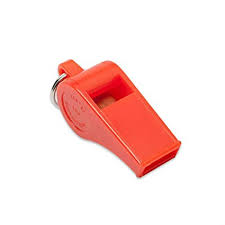A History of the Whistle
Listen to the Recess! Clip
| Author | Kevin Shortsleeve |
| Air Date | 11/6/2002 |

A History of the Whistle Transcript
Should it be any wonder that children love whistles? Whistles are happy – they fit neatly in little hands and little pockets and they endow their bearer with a disproportionate ability to be heard-loud and clear. The popularity of the whistle goes back-way way back. In fact, along with the drum, simple wind instruments are among the earliest man made musical devices. In 1995, in Slovenia, archaeologist Ivan Turk unearthed what many believe is the oldest wind instrument ever found. Carbon dated at 43,000 to 82,000 years old, this hollow Cave Bear femur bone segment is cut with a line of 4 holes that, amazingly, correspond with four notes of the do re mi scale. What is most surprising, and controversial, about this find is that it was discovered in the cave of a seemingly whimsical Neanderthal man.
Because Neanderthals were not supposed to be artistic in any way, the discovery set off a lot of bells and whistles. Some experts contend that the bear bone is actually not a flute, but is the result of natural causes, such as a marvelously straight set of identical teeth having bitten into an old bone. Solving that riddle is almost as hard as saying this:
A tutor who taught on the flute
Tried to teach two tutors to toot
Said the two to the tutor
Is it harder to toot or
To teach two tooters to toot.
The oldest whistle proper (that is, a wind instrument with only one hole) is also made from bone, is ten thousand years old and sits in the Pitt Rivers Museum at Oxford. Whistles and flutes have been around pretty much ever since then. The first major innovation-as far as children were concerned–came in 1843, when Robert Clarke of England made the first tin whistle. Legend has it, Clarke charged one cent for the toy and that’s where the name penny whistle comes from.
In the twentieth century, whistles were mass-produced and appeared to be in cahoots with every pop culture marketing plan that came down the turnpike. There was the Tom Mix Sliding Whistle, The Sergeant Preston of the Yukon Whistle, The Roy Rodgers Gold Badge with a whistle, and The Cracker Jack Flashlight Acme Whistle Toy. There was even a Dragnet whistle. And who could forget the H. J. Heinz 57 Pickle Whistle-or the Oscar Meyer Weiner Mobile Whistle?
And here at the University of Florida, where these radio programs are produced, we have our own special whistle. Home to the world famous Gator football team, our whistle (which has been banned from the football stadium) is appropriately shaped like a Gator-and even sounds like a Gator. And all you got do is, blow like a Neanderthal: